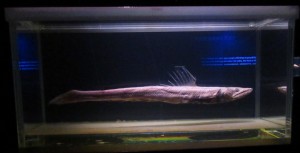Various Midwater Zones
The ocean is made up of 5 zones, as listed below.

0- 200m: Epipelagic Zone
This zone is usually the most crowded, since it receives most sunlight here.
200 – 1,000m: Mesopelagic Zone
Sunlight is faint, however still visible. Still relatively colonized.
1,000 – 4,000m: Bathypelagic Zone
Sunlight can no longer reach this zone. Temperatures rarely exceed 4 Degree Celsius.
Beneath 4,000m: Abyssopelagic Zone
Other than total reduction of sunlight and heavy water pressure, there is also very limited food resources and life.
To reflect how the Nouvian’s most popular work, the sub-categories under this Tab will follow the same categorization the exhibition had, which is slightly different from the above range of depth, starting from 150m instead. This is so that we dive straight into the deeper parts of the ocean. These categories include:
1. 150m – 600m: Epipelagic Zone to Mesopelagic Zone
2. 600m – 1000m: Mesopelagic Zone
3. Beneath 1000m: Mesopelagic Zone
4. Beneath 4000m: Abyssopelagic Zone
Each subcategory will serve to take you to a brief introduction of the different depths of the Deep sea virtually.
If you’re ready to start viewing the different zones, click HERE. ☺




